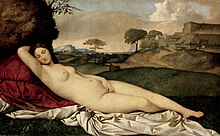Venus of Urbino

|
| Venus of Urbino |
|---|
| Titian , 1538 |
| Oil on canvas |
| 119 × 165 cm |
| Uffizi Gallery |
The Venus de Urbino is an oil painting by the Italian painter Titian from around 1538 . It depicts a naked young woman on a bed in an interior room. She is usually interpreted as the goddess Venus , although none of her usual attributes can be seen in the picture . Today the portrait is exhibited in the Uffizi Gallery in Florence .
Emergence
The painting was commissioned by Guidobaldo II della Rovere, probably in connection with his marriage to Giulia Verano (1523–1547) in 1534 and completed in 1538.
description
In the foreground, a young, unclothed woman lies on a bed, looking directly at the viewer. Except for a few pieces of jewelry, a ring, a bracelet and earrings, she is completely undressed. Her blonde hair is loose and flowing in soft waves onto her shoulders. In her right hand she holds a bouquet of roses , with her left hand she touches her shame, which is the focus of the composition. A sleeping dog lies at the foot of the bed.
In the right background of the picture, two female servants are busy with clothes and clothes lockers , one kneels in front of a clothes locker.
Interpretations
The portrait of the young woman has been interpreted controversially in art history. From one point of view, the portrait would like to be understood as a parable of marriage; for example, says the so-called marriage chest in the background, the parts of the dowry may have contained. According to the wedding picture theory, the picture should serve the erotic education of his underage bride Giulia Varano (born in 1523, married in 1534) by Guidobaldo II . The princess had to be prepared for the role of mother, which the dynasty had to secure. Other authors see the portrait of a courtesan in the Venus de Urbino , who almost completely reveals herself to the viewer.
It was also stated that the viewer is presented with a simile of conjugal sexuality in which provocative erotic aspects are combined with conjugal virtues (e.g. loyalty, attribute: dog).
Typologically, the portrait goes back to the Slumbering Venus Giorgiones , which was made shortly before and in which at least one of his pupil Titian's participation is assumed. The painterly skills typical of Tizian are perfectly brought together here: In particular, the painterly treatment of the various materials (hair, skin, fur, flowers, curtains, fabric cover, fabric wallpaper, precious stones, etc.) are so impressive that the viewer is almost deceived believes. For the painterly quality speaks u. a. also the use of sfumato , which atmospherically (i.e. without contours) allows the body to merge into its surroundings.

reception
A copy of Franz von Lenbach's picture from 1866 is kept in the Alte Pinakothek in Munich.
From the Venus of Urbino was Olympia by Édouard Manet inspired.
Lucian Freud's 1993 painting Evening in the Studio refers to both Titian's Venus de Urbino and Manet's Olympia .
literature
- Daniel Arasse : The woman in the chest. In: Daniel Arasse: Have a look! What can be discovered in pictures. Cologne, DuMont 2002, ISBN 3-8321-7138-X , pp. 87–125.
- Rose-Marie Hagen, Rainer Hagen: Masterpieces in detail. From the Bayeux Tapestry to Diego Rivera. Volume 1. Taschen, Cologne a. a. 2005, ISBN 3-8228-4787-9 .
- Marion Kaminski: Tiziano Vecellio, called Tizian. 1488 / 1490-1576. Könemann, Cologne 1998, ISBN 3-8290-0699-3 .
- Wieland Schmied (Ed.): Harenberg Museum of Painting. 525 masterpieces from seven centuries. Harenberg Lexikon Verlag, Dortmund 1999, ISBN 3-611-00814-1 .
Individual evidence
- ↑ Rona Goffen: Sex, Space and Social History in Titian's "Venus of Urbino". In: Rona Goffen (Ed.): Titian's “Venus of Urbino”. Cambridge University Press, Cambridge 1997, ISBN 0-521-44900-6 , pp. 63-90.
- ↑ Venus de Urbino, 1866 ( Memento of March 5, 2016 in the Internet Archive ). In: pinakothek.de, accessed on April 23, 2015.
- ↑ Figure ( Memento from March 30, 2016 in the Internet Archive ). In: wikiart.org, accessed May 22, 2015.
